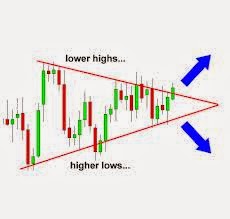There are several technical indicators, but every one does not need to study all, as that can confuse a Forex trader. It is better to concentrate to selected few indicators only. Some of the key indicators used in technical analysis are mentioned as below.
- Bollinger Bands
- MACD
- RSI
- Stochastic
- A middle band being a N-period simple moving average.
- An upper band at K times a N-period standard deviation above the middle band.
- A lower band at K times a N-period standard deviation below the middle band.
Typical values for N & K are 20 and 2 respectively.
If the price rise above the upper band, after having remained between the two bands for quite sometime, then it indicates that price is now bound to go higher and buying can be initiated. If the price falls below the lower band, after having remained between the two bands for quite some time, then it indicates that price is now bound to fall and hence selling can be initiated.
Many traders use the moving average line or middle line to initiate their trades. When the price of security rises above the middle line they initiate their buying and when the prices of a security falls below the middle line they initiate selling. below chart illustrates Bollinger band signals.
2. Moving Average Convergence Divergence (MACD): - MACD stands for Moving Average Convergence Divergence, is one of the commonly used indicators in Forex trading analysis. It was invented by Gerald Apple. MACD shows the relationship between two price moving averages. A 9 day EMA of MACD called the 'signal line", is then plotted on MACD, to give the buy and sell signals.
3. Relative Strength Index (RSI): - Relative strength Index is a popular momentum oscillator, developed by J. Welles wilder. RSI measures the relative changes between the higher and lower closing prices and turns the information into a number that ranges from 0 to 100. The 70 and 30 values are used as warning signals, whereas values above 85 indicates an overbought condition and values under 15 indicates an oversold condition and are relatively known as buying and selling signals.
4. Stochastic: - Stochastic oscillator is invented by George Lane, is a momentum indicator used in technical analysis. Stochastic oscillator is plotted on a scale of 0 to 100. It is used to provide by and sell signals and suggests over bought or over sold signals. Two oscillator indicators i.e., (%K) a fast indicator and (%D) a slow indicator are used for analysis. Where value of %K or %D goes above 80 it is considered to be over bought and when it falls below 20 it is considered to be over sold. Buy and sell Signals is given when %K crosses through the %D line. A buy signal is given when %K crosses up through %D and a sell signals when it crosses down through%D.

























